Amped Wireless R20000G, SR20000G, and UA2000: Routers, Repeaters, and Adapters (Oh My!)
by Jarred Walton on June 23, 2012 12:00 AM EST- Posted in
- wireless
- Networking
- 802.11n
- Amped Wireless
Test Location C Results: Worst-Case Performance
Our third and final test location is at a relatively extreme testing distance of 60 feet, with several walls plus a metal garage door in between the adapters and the routers. If Location B was Nightmare difficulty in Diablo III, we’re now firmly into the Hell difficulty. Anecdotally, I can also state that at this particular location, many wireless devices (e.g. my iPod Touch 4th-gen and a couple different tablets) also have serious problems connecting/maintaining a connection with my Netgear router—once I’m in my car and start leaving the driveway, WiFi gets dropped and I have to go back inside if I want to get a quick set of directions before heading out.
As far as testing this location goes, while I did manage to achieve connections with all three adapters and routers—even with the 5GHz signal—in practice the throughput was quite variable and very low. Day-to-day variance in testing was also even more pronounced this time; at one point I got nearly twice the throughput on one router+adapter combination, but I wasn’t able to repeat that performance so I discarded the earlier results. I also dropped the NTttcp testing for this location; my test script transfers 1.5GB of data, and while that only takes 2-5 minutes at the first test location and twice that at Location B, for this test location I could be looking at 20 minutes or more for some of the test cases this time. Run that five times over 26 router/adapter combinations and—assuming everything even worked out properly—I’d be looking at two solid days sitting out in my driveway. The file copy tests thankfully only use 203MiB and generally correlated well with the NTttcp results, so I’ve just used those tests.
Keep in mind that Amped also claims up to 10000 square feet of coverage for the R20000G; at 60 feet, we’re actually slightly beyond that point, so the question is more whether you think 60 feet from your router is really all that impressive. Personally, I’d be more than a little disappointed if my wireless network couldn’t reach at least 60 feet and through a couple walls. Out in the open, I’d think a couple hundred feet (e.g. in a parking lot) would be easy enough for most decent wireless routers. Anyway, let’s see what happens at our “extreme” range.
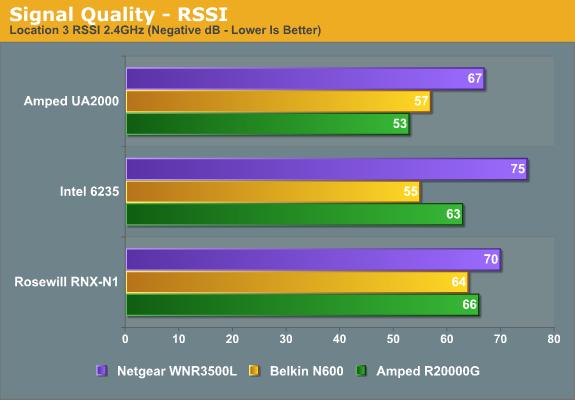
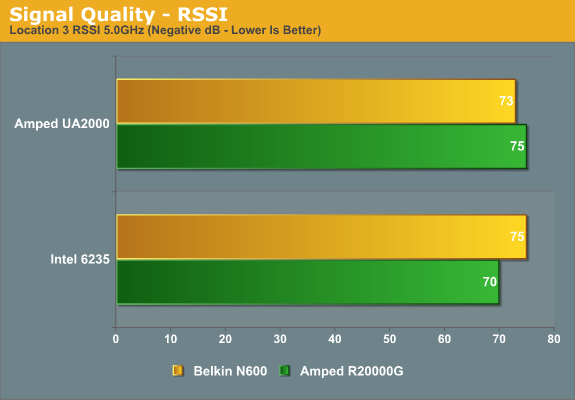
RSSI is now starting to get into the range where connections get flaky, particularly with the 5GHz spectrum. -70dB or higher (e.g. -60dB) is usually sufficient for getting and maintaining a connection, but beyond that I typically see some drops and need to reconnect. Amped advertises the R20000G as a superior “long distance” router, but while the RSSI values are better than those of the Netgear, the Belkin N600 actually claims several wins this time. It’s possible that if the Belkin router is tuned more for distance than throughput, it might actually surpass the Amped router this time.
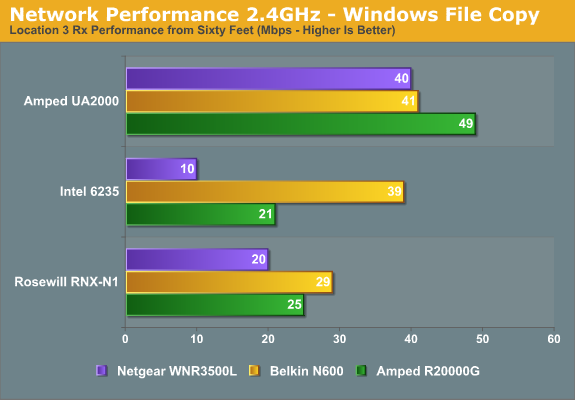
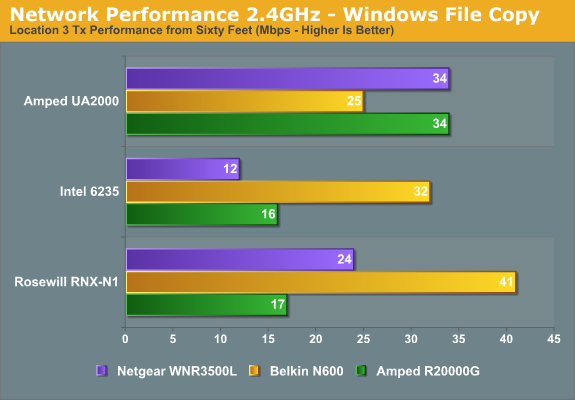
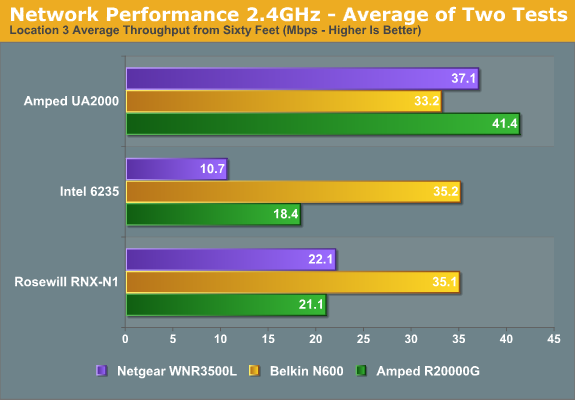
Given that testing was done over the course of several days with different weather patterns, I’m not sure just how much detail we can draw from the above charts. The UA2000 adapter generally beats the other two adapters, but it’s possible some of the results are simply “luck of the draw”. In terms of routers, the Belkin N600 comes out on top this time, delivering relatively constant performance with all three adapters—it ends up nearly 50% faster than the Netgear router and just over 25% faster than the Amped R20000G. Meanwhile, for average performance the UA2000 is about 75% faster than the Intel 6235 and 45% faster than the Rosewill RNX-N1. I was actually hoping for even more at this location, considering Amped advertises 600mW transmit power on the UA2000, but a 50% or more improvement is hardly something to scoff at.

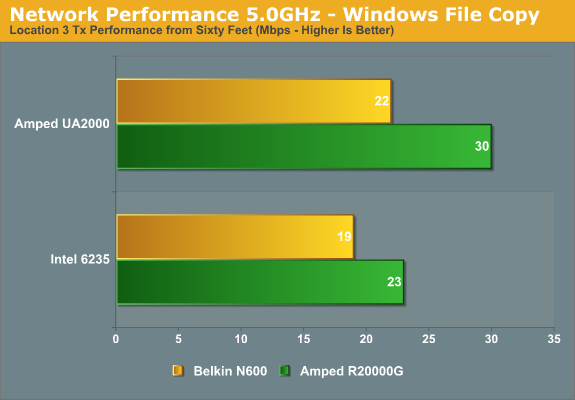
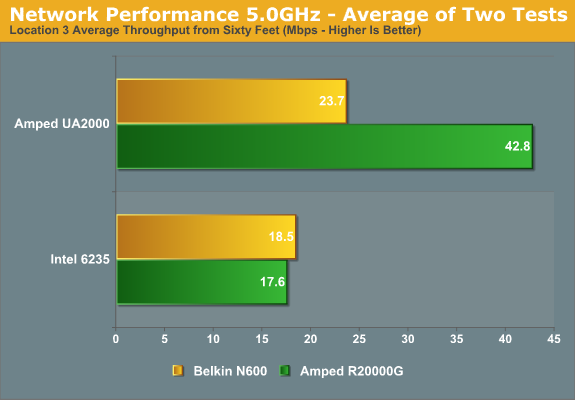
With 5GHz, the Amped + Amped combination delivers some awesome results, but again I have to question if these are reliable results or not given the variability—there were certainly times where the UA2000 managed far less than 20Mbps for example. As it stands, the UA2000 directional adapter is on average 84% faster than the Intel 6235 omnidirectional adapter—and that makes sense as signal strength drops off rapidly as we move away from the source. The R20000G also comes out on top, though that’s largely thanks to the stellar result with the UA2000; it ends up being 43% faster than the Belkin N600, but it’s really a case of nearly equal performance with the Intel 6235 (with the Belkin actually having a small 5% lead) and a massive 81% gulf with the UA2000.
If I had been wise, I would have tabulated all the individual results and come up with a throughput distribution graph (similar to what Brian does with our smartphone Speedtest results), but unfortunately I only considered doing that after the fact. It would also become rather difficult to compare results between routers and adapters using such charts. Still, if there’s enough desire for such testing, I can revisit the subject with a smaller article. Either leave a comment or drop me an email if you’re interested in such testing.










28 Comments
View All Comments
Conficio - Sunday, June 24, 2012 - link
I wonder why Amped Wireless would not combine the repeater and the directional antenna. As Jarred mentioned, for a mobile device a directional antenna is a bit inconvenient, especially if it does easily move.However for a repeater it would be ideal. Place your repeater in a quite weak spot and use the power of the directional antenna to still get a good signal. Then broadcast the repeated signal onmi-directional. That should cut down on the interference too. And a repeater is a heavier object to begin with and stationary. Sure if you don't need it, then you won't need it. But if you have a tricky situation, or simply a very large property (lets say a boats house or an artists shed) then this should be a great solution.
Even better would be to add an additional directional antenna to the main router and the ability to use different channels for the directional link. That could make a point to point link that would cut down on interference even more.
JarredWalton - Sunday, June 24, 2012 - link
I believe Amped does support this, though you'd need to provide the antennas yourself (Amped sells them, though). The only problem is that you'd basically have one antenna directional and pointed at the router with the second omnidirectional, so your total omnidirectional signal strength would likely be limited.Conficio - Monday, June 25, 2012 - link
Thanks Jarred for clarifying this.In my mind that poses one more question, is the directional USB stick a 2x2 config? are both antennas directional? Or is it only one antenna?
But I think you are right, just replacing an antenna with a directional one is not the same as building a real repeter that has a separate notion of (set of) input antenna (directional) and set of output antenna (omnidirectional). Hence there is the opportunity for a company like Amped.
Another question. Is it possible to use only one band (5GHz) to talk to the router and the other band (2.4 GHz) to redistribute? The same for channels? Which should get down the interference even better.
JarredWalton - Monday, June 25, 2012 - link
AFAIK, the UA2000 has both antennas pointing the same direction. It can also pick up other routers that aren't being pointed at, but range and performance drop considerably.As for routing one band to the router and the other for talking to devices, I asked Amped about this, and they said while in theory it's possible to have the repeater send wireless traffic over the other connection (when present), they chose not to do it this way to "keep things simple" or something. If you use a 2.4GHz only router (or disable the 5GHz channel), then 5GHz traffic will get routed over the 2.4GHz radio; likewise, you could disable your router's 2.4GHz channel and have the repeater's 2.4GHz traffic route over 5GHz. That might actually be interesting to test out.
mike8675309 - Tuesday, June 26, 2012 - link
I actually do that in my home. Using DD-WRT I have a WDS network setup with 3 dual radio routers. Clients connect on the 2.4GHz antennas and the routers talk to each other over the 5GHz antennas.PS3, Xbox, Dish DVRs connect with ethernet and get a 5Ghz connection to the internet router, perfect for streaming from Netflix or Dish.
This eliminates the issue with 1/2 the bandwidth when using the same radio to talk to clients as you use for repeating to the main router, which is what is happening for most repeaters in the market.
tlcqualityrentals - Tuesday, July 3, 2012 - link
Lots of great information on this site. If only I could figure out what you guys are talking about. LOL. I had narrowed down my selection to the Amped Wireless R20000g to replace my years 5+ year old Linksys router/modem. The Linksys was fine for my home. I have recently added a cottage and a pavilion to my property. Both are approximately 300 to 400 feet from the Linkysys router. It is imperative that i provide good network coverage in the cottage. My question to you is, how would you solve this issue? What items would you buy?Thanks for any suggestions.
Much appreciated.
Rhonda
bman212121 - Monday, June 25, 2012 - link
One of the biggest issues when trying to pick a wireless AP for range is dechipering through all of the claimed power ratings. I bought an AP that was listed as having a 400mW power rating. I figured that meant that it was a 200mW radio output and 200mW for the 3dbi antennas on it. That is technically true but the issue with N is that those numbers are also divided by the number of antennas you have. So in reality it was 100mW per amp with 100mW (3dbi gain) for each antenna.So in the case of this amped wireless device it would be 125mW (21Db) amps and 5dbi antennas (26dbi EIRP per antenna, making 29dbi total power output) This would make it slightly more powerful than the average home router but for devices where you can replace the antennas you will get more power by having bigger antennas than what is provided on this device.
Case in point, I was floored when our old Linksys WRT54G actually out ranged my 400mw N access point because it used the same 100mw (20Dbm) output and a 2dbi antenna. I'm guessing it must have had a slightly better method of determining the best path and probably a bit more sensitive receiver. I was already planning on swapping the antennas with 9dbi rubber duckies. Once I did that then my AP was able to travel farther however location seems to be far more important for range than anything you can do on the AP side.
GullLars - Sunday, July 8, 2012 - link
"If I had been wise, I would have tabulated all the individual results and come up with a throughput distribution graph (similar to what Brian does with our smartphone Speedtest results), but unfortunately I only considered doing that after the fact. It would also become rather difficult to compare results between routers and adapters using such charts. Still, if there’s enough desire for such testing, I can revisit the subject with a smaller article. Either leave a comment or drop me an email if you’re interested in such testing."Yes, when there are very variable results, using result distribution graphs can give very important information averages leave out, like best and worst case, and consistency of performance.
I'd rather have a wireless connection at average 80Mbps ±10Mbps than average 140Mbps with drops to 40Mbps 10% of the time. Especially if this is also reflected in latency. I'm kinda surprised there were no meassuring of ping, just throughput. Ping and ping spikes are very important for how it feels to use wireless connections.
For most rewiews of IO devices there is mention of both throughput and latency, why not also do this for wireless?